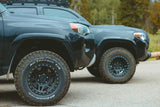What Midwest Salt and Time Can Do to Your Truck — and How to Beat It Before the Lift Goes On
You’ve bought the lift kit. You’ve got the tools. Maybe you’ve even cleared out your Saturday. But before you jack up your truck and start wrenching, there’s something rusting away below the surface—literally.
If you live in the Rust Belt or any region where road salt, moisture, or snow reigns supreme (we’re looking at you, Michigan, Ohio, Pennsylvania, and New York), your undercarriage is probably fighting a slow, silent battle against corrosion. And installing a lift kit on a rusty frame? That’s like putting a gold crown on a rotting tooth.
This guide will show you how to prepare your undercarriage properly before you lift, avoid costly mistakes, and ensure your truck stays safe, functional, and fierce-looking.
The Science of Rust: Why It’s Worse Than You Think
Road salt lowers the freezing point of water, keeping roads less icy—but it comes at a cost. That salt solution gets flung up by your tires, coating your frame, axles, leaf springs, and bolts. When it mixes with water and oxygen, it accelerates oxidation. Once surface rust forms, it doesn't stop—it spreads, flakes, and eats through metal like termites in a log cabin.
Worse still: rust doesn’t just weaken the metal—it can hide structural damage beneath seemingly minor surface stains.
Before you add the weight and torque stress of a lift kit, you need to assess and address any damage hiding under your truck.
Pre-Lift Inspection: Don’t Skip This Step
1. Get It Up in the Air
Use ramps, jack stands, or (ideally) a shop lift. You want full access to the undercarriage. Use a good light and a stiff wire brush to remove dirt and surface debris.
2. Look for These Red Flags:
-
-
Flaking metal or soft spots on the frame
-
Rust near welds or critical mounting points
-
Frothy or bubbly rust patches (a sign of deeper penetration)
-
Rust around leaf spring hangers, control arms, or shock mounts
-
Frozen or fused bolts, where you’ll need to remove hardware
-
3. Tap with a Hammer
This old-school method works. Tap areas of concern. If the metal crumbles or sounds dull instead of pingy, it's likely compromised.
Surface Prep: Clean First, Protect After
1. Degrease and Wash
Use a degreaser or pressure washer (especially if you’ve got caked-on grime and salt). Just be careful not to force water into electrical connections or sealed joints.
2. Mechanical Rust Removal
-
-
Use a wire wheel on a drill or grinder for large areas.
-
A needle scaler works well for thick flakes.
-
For tight spaces, hand wire brushes and scrapers will do.
-
3. Convert It or Kill It
-
-
Apply rust converter to any remaining oxidation. This turns iron oxide into a stable compound that can be painted over.
-
Or use rust encapsulators that seal over affected areas.
-
Prime and Protect
Once your metal’s clean, it's time to lay down armor:
-
Primer: Apply a rust-inhibiting primer designed for automotive or chassis use.
-
Paint: Use an undercarriage paint or epoxy enamel.
-
Undercoating (optional): Rubberized or wax-based undercoats add extra resistance—but only after full prep. Never spray them over active rust.
Pro tip: Use frame coatings that remain flexible to withstand flex, mud, and gravel impact—brands like POR-15 or Eastwood are industry standards.
Smart Installation Tips for Lift Kits on Rust Belt Trucks
-
Soak bolts in PB Blaster or Kroil 24 hours ahead of time.
-
Have replacements ready—OEM bolts and bushings often snap during disassembly.
-
Use anti-seize compound when reassembling to prevent future headaches.
-
Torque to spec—don’t over-tighten corroded areas just to “make them hold.” You're asking for a crack or failure down the line.
The Safety Factor
You might think “it’s just a little surface rust,” but your suspension mounts are literally what keep your truck off the ground. Rusty welds, weakened control arm brackets, or brittle frames can fail catastrophically when stressed by a lift, oversized tires, or aggressive driving.
If your inspection reveals deep rust in structural areas—don’t install the lift yet. Call a welding pro or body shop. A $200 patch job now beats a $5,000 frame-off rebuild later.
Final Thoughts: Respect the Rust
Lifting a truck is more than just a cosmetic mod—it’s a performance upgrade that changes geometry, weight distribution, and force vectors. Adding that kind of load to a corroded chassis is like building a skyscraper on wet sand. Take a day to prep your frame right, and it’ll reward you with years of safe, solid performance! Especially in the Rust Belt, treating the undercarriage like a critical component—not an afterthought—makes all the difference!
At Reaper Offroad Lifts, we provide heavy-duty u-bolt kits that meet or exceed OEM specs — corrosion-resistant, properly sized, and ready for real-world abuse. Whether you’re daily driving, towing, or off-roading, secure your build with confidence!





0 comments